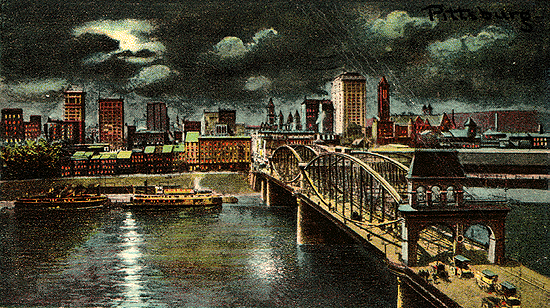

Undated Circa 1909
Undated 27 June 1912
1890s 21 May 1949
In 1896 In 1972
Circa 1908 [14 December 1975]
From program of Presentation Ceremony in Recogniton of The Smithfield Street Bridge as a National Historic Civil Engineering Landmark by the American Society of Civil Engineers, Friday, June 18, 1976.
The Smithfield Street Bridge, Pittsburgh, Pa., probably the oldest extant major steel truss in the United States, has been designated a National Historic Civil Engineering Landmark. This bridge represents a unique adaptation of contemporary (1883) European engineering practice, the lenticular truss, to American needs. It served as a guide for the many highway bridges of similar design built in America during the ensuing decades.
The Smithfield Street Bridge across the Monongahela River connects the downtown Pittsburgh area with the South Side of Pittsburgh. A ferry served as a transportation means between the two areas prior to 1810, when a charter was issued for construction of a bridge. In 1816, the first Smithfield Street Bridge was built. It was a covered wooden bridge, consisting of eight truss spans, each being 188 feet long. These were reinforced with timber arches. In 1845, this bridge was destroyed by fire and was replaced in 1847 by a wire rope suspension bridge designed by John Roebling, and operated as a toll bridge. It was Roebling's first highway bridge and it carried increasingly heavier live loads, causing excessive deflections, swaying and vibrations. The structure was consequently condemned. Roebling was later to design the world famous Brooklyn Bridge, which is a National Historic Civil Engineering Landmark.
In 1881, the Bridge company responsible for building, operating and collecting tolls for the suspension bridge, was reorganized with a program calling for an improved structure that would safely support the increasing traffic loads and speeds. Plans meeting these requirements were submitted by Gustav Lindenthal, famous American bridge builder. He was later to design many other notable bridges including the Allegheny Bridge also in Pittsburgh and the Hell Gate Bridge in New York City.
By 1911, the City of Pittsburgh took over responsibility for the structure and among other improvements, eliminated tolls. In 1958, Pittsburgh transferred responsibility for the bridge to the Highway Department, Commonwealth of Pennsylvania.
The Smithfield Street Bridge is one of 50 National Historic Civil Engineering Landmarks designated to date. As part of its professional activities, the American Society of Civil Engineers conducts a program to identify landmarks which represent significant contributions to the development of America.